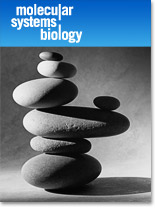| |||||||||||||||||||||||||||||||||||||||||||||||||||||||||||
| |||||||||||||||||||||||||||||||||||||||||||||||||||||||||||
| Advertisement | ||
| Molecular Systems Biology has a fair and transparent process to rapidly publish your best science. Transparent - No confidential referee remarks - Published referee reports - Detailed decisions Fair - Scooping protection - Pre-decision cross-referee commenting - Fixed bar for revisions - Fast process Submit your paper today! | ||
You have been sent this Table of Contents Alert because you have opted in to receive it. You can change or discontinue your e-mail alerts at any time, by modifying your preferences on your nature.com account at: www.nature.com/nams/svc/myaccount (You will need to log in to be recognised as a nature.com registrant). For further technical assistance, please contact our registration department. For print subscription enquiries, please contact our subscription department. For other enquiries, please contact our customer feedback department. Nature Publishing Group | 75 Varick Street, 9th Floor | New York | NY 10013-1917 | USA Nature Publishing Group's worldwide offices: Macmillan Publishers Limited is a company incorporated in England and Wales under company number 785998 and whose registered office is located at Brunel Road, Houndmills, Basingstoke, Hampshire RG21 6XS. © 2012 Nature Publishing Group, a division of Macmillan Publishers Limited. All Rights Reserved. | ||
 | ||








No comments:
Post a Comment